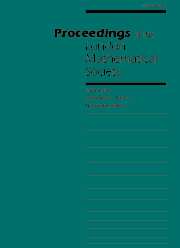Crossref Citations
This article has been cited by the following publications. This list is generated based on data provided by
Crossref.
Hug, Daniel
and
Last, Günter
2000.
On support measures in Minkowski spaces and contact distributions in stochastic geometry.
The Annals of Probability,
Vol. 28,
Issue. 2,
Aarts, Jan
Brouwer, G.
and
Oversteegen, Lex G.
2009.
Centerlines of regions in the sphere.
Topology and its Applications,
Vol. 156,
Issue. 10,
p.
1776.
Bishop, Christopher J.
2010.
Conformal Mapping in Linear Time.
Discrete & Computational Geometry,
Vol. 44,
Issue. 2,
p.
330.
2014.
Mathematical Foundations of Image Processing and Analysis 1.
p.
309.
2014.
Mathematical Foundations of Image Processing and Analysis 2.
p.
349.
Cuevas, Antonio
Llop, Pamela
and
Pateiro-López, Beatriz
2014.
On the estimation of the medial axis and inner parallel body.
Journal of Multivariate Analysis,
Vol. 129,
Issue. ,
p.
171.
Yukich, J. E.
2015.
Surface order scaling in stochastic geometry.
The Annals of Applied Probability,
Vol. 25,
Issue. 1,
Balinsky, Alexander A.
Evans, W. Desmond
and
Lewis, Roger T.
2015.
The Analysis and Geometry of Hardy's Inequality.
p.
49.
Galusinski, C.
and
Nguyen, C.
2015.
Skeleton and level set for channel construction and flow simulation.
Engineering with Computers,
Vol. 31,
Issue. 2,
p.
289.
Thäle, Christoph
and
Yukich, J.E.
2016.
Asymptotic theory for statistics of the Poisson–Voronoi approximation.
Bernoulli,
Vol. 22,
Issue. 4,
Crasta, Graziano
and
Fragalà, Ilaria Fragalà
2016.
On the characterization of some classes of proximally smooth sets.
ESAIM: Control, Optimisation and Calculus of Variations,
Vol. 22,
Issue. 3,
p.
710.
Birbrair, Lev
and
Denkowski, Maciej P.
2017.
Medial Axis and Singularities.
The Journal of Geometric Analysis,
Vol. 27,
Issue. 3,
p.
2339.
Hug, Daniel
Kiderlen, Markus
and
Svane, Anne Marie
2017.
Voronoi-Based Estimation of Minkowski Tensors from Finite Point Samples.
Discrete & Computational Geometry,
Vol. 57,
Issue. 3,
p.
545.
Berezsky, Oleh
and
Zarichnyi, Mykhailo
2021.
Advances in Intelligent Systems and Computing V.
Vol. 1293,
Issue. ,
p.
188.
Liang, Xiangyu
2022.
On the dimension of the k-medial axis for an arbitrary closed set.
Journal d'Analyse Mathématique,
Vol. 147,
Issue. 1,
p.
29.
Hug, Daniel
and
Santilli, Mario
2022.
Curvature measures and soap bubbles beyond convexity.
Advances in Mathematics,
Vol. 411,
Issue. ,
p.
108802.
Kolasiński, Sławomir
and
Santilli, Mario
2023.
Regularity of the distance function from arbitrary closed sets.
Mathematische Annalen,
Vol. 386,
Issue. 1-2,
p.
735.
Białożyt, Adam
2023.
The tangent cone, the dimension and the frontier of the medial axis.
Nonlinear Differential Equations and Applications NoDEA,
Vol. 30,
Issue. 2,
Miura, Tatsuya
and
Tanaka, Minoru
2024.
Delta‐convex structure of the singular set of distance functions.
Communications on Pure and Applied Mathematics,
Vol. 77,
Issue. 9,
p.
3631.
Balitskiy, Alexey
Coskunuzer, Baris
and
Mémoli, Facundo
2025.
Geometric bounds for persistence.
Transactions of the American Mathematical Society,

